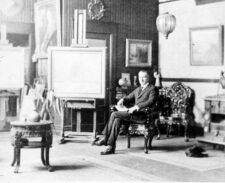Jack Wilkinson Smith (1873-1949)
Available Work
Biography
Press and Publications
Pioneers of Artists’ Alley (Victor Clyde Forsythe, Frank Tenney Johnson, Jack Wilkinson Smith, Eli Harvey, Norman Rockwell) by Elaine Adams, California Art Club Newsletter, Summer 2007
At the start of the twentieth century, California attracted an eclectic array of creative and philosophical thinkers who were lured out west in search of the spirit of adventure that …
Continue Reading »

 Jack Wilkinson Smith was originally from the East Coast, but had a Western spirit. He was born in Paterson, New Jersey on February 7, 1873 to an artist-father who painted some of the decorations in New York’s state Capitol Building in Albany. His East Coast roots were deep, as his grandfather owned an eighty-acre farm in New York, which now includes Madison Square Garden.
Jack Wilkinson Smith was originally from the East Coast, but had a Western spirit. He was born in Paterson, New Jersey on February 7, 1873 to an artist-father who painted some of the decorations in New York’s state Capitol Building in Albany. His East Coast roots were deep, as his grandfather owned an eighty-acre farm in New York, which now includes Madison Square Garden.